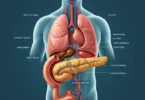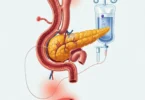Diabetic Ketoacidosis
The ketoacidosis is a dangerous metabolic derangement, which is triggered by insulin deficiency. Undetected and untreated, ketoacidosis can develop a life-threatening diabetic coma. Ketoacidosis occurs mainly in people with type 1 diabetes.
The hormone insulin has the function to smuggle dextrose (glucose) from the blood into the body cells. There, the sugar is needed for energy production.In the absence of insulin, the cells start break down of fat as a substitute. This produces acidic metabolites, so-called ketone bodies. These accumulate in the blood and can lead to acidification, an acidosis. That’s way we called ketoacidosis.
In type 1 diabetes, the body produces little or no insulin. So affected person are therefore particularly susceptible to the metabolic derangement. For people with type 2 diabetes, the risk of ketoacidosis is much lower than type 1 diabetes. In type 2 diabetes the body have usually still own insulin, however, due to insulin resistance the sugar can not sufficiently infiltrate out of the blood into the body cell.
Causes Of Kitoacidosis
The most common cause (30 to 40%) of ketoacidosis in diabetics are infections – particularly pneumonia, urinary tract infections and abscesses. Despite febrile infections because of low appetite and reduced food intake requirement of insulin is increase, so that the normal dosage may be too low. Also forgotten doses or low insulin dose or technical problems with the insulin pump therapy are a common trigger (20 to 40% of cases) for ketoacidosis.
In both situations, the organism lacks insulin, so blood glucose cannot be transported as a source of energy in the body cells. To compensate for the lack of energy, on one hand the liver produces new glucose, which further increases the hyperglycemia. On the other hand the organism metabolizes fat which result in increase in so-called fatty acids. This oversupply of fatty acids is incompletely degraded to ketone bodies, which ultimately leads to acidification.
Among the rarer causes of ketoacidosis include,
- heart attack
- pulmonary embolism
- stroke
- alcohol abuse
- taking cortisone.
Symptoms Of Ketoacidosis:
- Intense thirst
- Abdominal pain,
- nausea or vomiting
- Dry skin or mucous membranes
- Disorders of consciousness
- stomach pain
- A smell of acetone in breath (smells like nail polish or fruity)
- Deep breathing
- Severe tiredness or sleepiness
- Frequent urination (polyuria)
- Nocturnal urination (nocturia)
- Weakness
- Drowsiness, confusion
- Blurred vision
Check Blood On Acidification
With appropriate signs or suspicion of ketoacidosis, as well as if blood glucose levels is at about 250 mg/dl sufferers should definitely check acidification of the blood. There are suitable acetone urine test or a blood glucose meter with special ketone test strips are used to check. The doctor may give preliminary advice on the correct use of these tools.
Every patient with diabetes should also discussed with his doctor, which measures he and his family take in case of ketoacidosis. In an emergency, it is important to know exactly what to do in order to act quickly.
Treatment Of Ketoacidosis
The treatment of ketoacidosis depends on how far the disease has progressed. If there is an emergency like a person is in coma than he need an immediate intensive medical care at the hospital. Breathing and circulation must be secured as well as the internal organs are protected from failure.
It is always important to maintain an adequate hydration, which is carried out via an intravenous access. If patient have very low pH of the blood and a pronounced acidosis, compensating substances can be added, which buffer the acid metabolism in the blood. To balance the electrolyte balance again, a sodium or potassium replacement is often necessary.
In the case of diabetic ketoacidosis, insulin is given in order to transport the sugar molecules into the cells. Diabetics should be informed by their doctor about the risk of ketoacidosis and get recommendations for the correct behavior at the first signs of metabolic imbalance.






